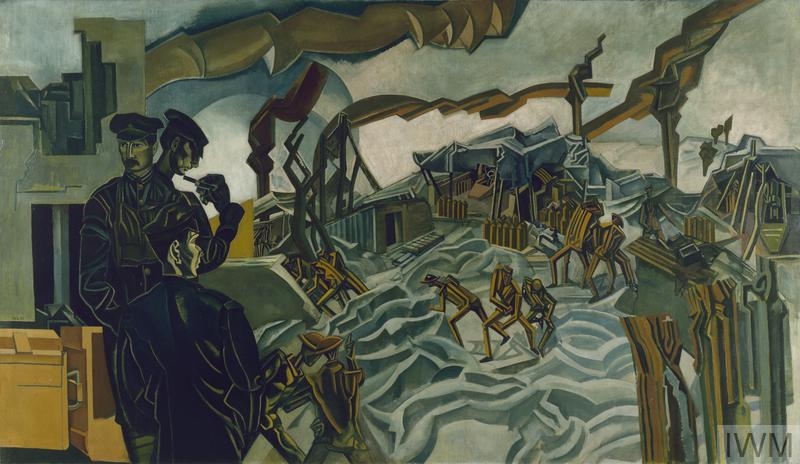An exhibition highlighting the work of Percy Wyndham Lewis, artillery officer at the Third Battle of Ypres and challenging war artist, is under way at Imperial War Museum North in Manchester. CN Editor Peter Alhadeff went to see it.
In First World War terms, Wyndham Lewis is remembered not only for his strikingly original depictions of Passchendaele, but also his hunch, expressed in a post-war memoir, that the very name of this Flanders ridge spelt misfortune.
However, this exhibition at IWM North, part of events marking the Imperial War Museum’s own Centenary in 2017, is a reminder too of Wyndham Lewis’ wider significance as a pioneer of British modern art, and how it might have developed had the Great War not intervened.
So it’s much more than a display of war art, charting the entire course of his turbulent life and career.
Nevertheless, A Battery Shelled, his painting of British troops under fire in Flanders, drawing on his own experiences as an artillery officer, stands out today as a monumental example of his greatest achievements.
Yet, a century ago, the work was one of the most controversial to emerge from the First World War.
 A Battery Shelled, oil on canvas 1919 (© IWM ART. 2747): Wyndham Lewis’ typically robotic-like soldiers scurry across a landscape devoid of normality, while in the foreground, three artillery observers look on, almost indifferently.The scene is intended to convey a ‘sense of otherness of the Western Front.’ But many critics felt it was inappropriate as a memorial when it was first exhibited at London’s Royal Academy in 1919.
A Battery Shelled, oil on canvas 1919 (© IWM ART. 2747): Wyndham Lewis’ typically robotic-like soldiers scurry across a landscape devoid of normality, while in the foreground, three artillery observers look on, almost indifferently.The scene is intended to convey a ‘sense of otherness of the Western Front.’ But many critics felt it was inappropriate as a memorial when it was first exhibited at London’s Royal Academy in 1919.
Percy Wyndham Lewis (he dropped his disliked forename) enlisted with the Royal Garrison Artillery in 1916. He served at the Battle of Messines in June 1917 before returning to the Ypres salient in late August as British-led forces attempted to rescue their offensive from the mire.
He took part in the successful actions at Polygon Wood and Zonnebeke, before being appointed an official war artist in December 1917, first by the Canadians (he was born in Nova Scotia), and later the British.
The shell-blasted fields of Passchendaele, with their shattered tree stumps, are unmistakeable in Wyndham Lewis’ drawings, illustrating what he called ‘an epic of mud.’
For curator Richard Slocombe, the anniversaries falling in 2017 made him a ‘good fit’ for the Imperial War Museum’s biggest visual arts exhibition to date, in the centenary year of its own foundation.
“Wyndham Lewis died in 1957, so it’s 60 years since his death. He became an official war artist in 1917, and we are the repository of the official war art schemes – and of course it’s the Centenary of Passchendaele,” Slocombe told Centenary News.
Radical
Wyndham Lewis: Life, Art, War spans the artist’s entire career, from the radical who founded ‘Vorticism’, Britain’s only true avant-garde movement, on the eve-of-war, through to the battlefields of Passchendaele, and his re-invention as a writer.
Along the way, Wyndham Lewis feuds with his fellow artists and writers, whether they be the artistic establishment or the ‘Bloomsbury Set’ of intellectuals. In the 1930s, he was tainted by his sympathies for fascism, before reassessing his opinions in 1937 following a visit to Nazi Germany.
Richard Slocombe, Senior IWM Curator and art historian, notes: One never really gets to the bottom of Wyndham Lewis; he is elusive and contrarian. That’s what makes him so fascinating.”
“Lewis lived through incredibly turbulent times where war, or the threat of war, was ever present.
“This exhibition will shed light on the work of a highly-gifted, original, but often ignored artist and one of the great personalities of the twentieth century.”
‘Wyndham Lewis: Life, Art, War’ is at IWM North, Manchester, until 1 January 2018. For more details see the IWM website.
Images courtesy of Imperial War Museums © IWM Art. IWM ART 2747 (‘A Battery Shelled’); Centenary News (museum building)